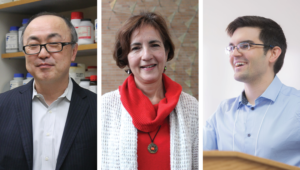
In the 2020–21 fiscal year, School of Pharmacy researchers received six patents to improve drug delivery and discovery
By Jill Sakai
The University of Wisconsin–Madison has a long tradition of innovation and excellence in research. Bolstered by the Wisconsin Idea, UW–Madison’s scientists prioritize discovery-driven research that aims to improve the lives and livelihoods of residents throughout the state and beyond.
One place that success shines is in the number of patents awarded to UW–Madison researchers each year. Patents play a key role in academic research and discovery, representing the innovations at the forefront of new technologies and processes. The Wisconsin Alumni Research Foundation (WARF), which manages UW–Madison’s intellectual property, regularly ranks among the top universities worldwide for the number of U.S. utility patents granted each year. In 2020, WARF ranked seventh on this list; in 2019, it was ninth.
That tradition of excellence holds strong in the School of Pharmacy, with its longstanding commitment to advancing patient care through research, education and service in pharmaceutical, social and clinical sciences.
School of Pharmacy faculty, staff and students received patents for six discoveries in fiscal year 2020–21.
“The research enterprise here at the School of Pharmacy is one of our defining features,” says School of Pharmacy Dean Steve Swanson. “The number of patents coming out of our labs is a wonderful indication of not only the strength of the work but also of the real impact the School can make on the discovery, development, and delivery of new and improved therapeutics.”
Lipid-Free Drug Formulations
Patent: “Fluoropolymer emulsions with perhalogenated stabilizer for the delivery of hydrophobic drugs”
Issued September 1, 2020
SoP inventor: Professor Sandro Mecozzi
Many injected pharmaceuticals are dissolved in oil-based solutions. The common anesthesia inducer propofol, for example, is given to millions of surgical patients each year in a soybean oil-based emulsion.
But lipids in an emulsion can act as a bed for microbial growth, which would be incredibly dangerous to patients if injected into the blood. “Bacterial contamination is an enormous issue with propofol,” says Sandro Mecozzi, professor in the School’s Pharmaceutical Sciences Division. Propofol is often manufactured in 20 milliliter bottles, but a typical surgery patient might only require 10 or 11 milliliters. “Once you puncture a bottle, you may contaminate it, and the remaining nine milliliters can’t be reused. So a lot of it is wasted,” he says.

Working with UW–Madison anesthesiologist Robert Pearce, Mecozzi’s team designed a new type of drug-delivery system that eliminates lipids, such as soybean oil, in drug formulations and replaces them with a novel fluorine-containing compound, perfluorooctyl bromide.
“Contamination is not an issue, because bacteria can’t metabolize those fluorinated compounds,” Mecozzi says. “The bacteria don’t know what to do with it.”
The perfluorooctyl bromide also breaks down more slowly than lipids in the body, enabling controlled release of the drug molecules. “The main idea was to make sure that we would have particles that will be stable enough, long enough in blood so that they would provide controlled delivery for an extended time — something that is very difficult to achieve,” Mecozzi says. “The use of an inert and safe fluorous nanodroplet to organize the self-assembly of a nanoparticle is a completely novel way of thinking about drug nanocarriers, how they behave in blood and using that to control drug delivery.”
In the newly patented process, the researchers stabilize a droplet of perfluorooctyl bromide with a polymer that contains a fluorine-binding region along with a hydrophilic component and a very small hydrophobic component. They can then load propofol or another hydrophobic drug into the shell of the stable nanopolymer for injection into the blood, where it will circulate and release the drug slowly. The perfluorooctyl bromide breaks down over the next two or three days and be excreted from the body.
The system is essentially a template that can be used to deliver nearly any injectable hydrophobic drug, Mecozzi says.
In early studies with rats, their fluorine-based formulation of propofol rapidly anesthetized the animals in about 20 seconds. The team is continuing preclinical studies.
“The hope is that we can develop a better formulation of propofol that can advance to clinical trials and, eventually, result in a better experience for patients,” Mecozzi says.
Cyphomycin, A Novel Antifungal Compound
Patent: “Cyphomycin, compositions and uses thereof”
Issued June 8, 2021
SoP inventor: Professor Tim Bugni
The spread of drug resistance among bacterial and fungal pathogens leaves patients vulnerable to infections against which there are few or no effective treatments. Finding new compounds that are able to fight off drug-resistant pathogens is an area of high medical need.

As part of a Center of Excellence for Translational Research at UW–Madison, established in 2019 with support from a five-year, $30 million grant from the National Institutes of Health, School of Pharmacy Professor Tim Bugni and UW–Madison colleagues Cameron Currie and David Andes are finding novel compounds that are active against multi-drug resistant fungal infections, such as Candida auris and Aspergillus fumigatus.
In their search, the researchers focus on bacteria that live in symbiotic relationships with animals. Often such bacteria produce molecules that help protect their hosts. Working with Brazilian colleagues, the team isolated a new active compound from a bacterium that lives on a Brazilian fungus-farming ant and named it cyphomycin.
“In our preliminary studies, this antifungal agent has shown safety and efficacy in a mouse model, including against the opportunistic pathogen Candida albicans,” Bugni says.
On the basis of this activity, the researchers received a patent for cyphomycin in June 2021. Bugni’s group has determined the chemical structure of the molecule, which does not resemble other known antibiotic drugs. This increases the chances that the molecule may act against Candida through a biological process distinct from that of existing drugs and could be less susceptible to known mechanisms of resistance.
“We’re hopeful that this discovery-based approach will yield new kinds of compounds that can overcome existing resistance mechanisms and offer new hope against some of these especially nasty pathogens,” Bugni says.
Targeted Degradation of Disease-Causing Proteins
Patent: “Synthesis of small molecule histone deacetylase 6 degraders, compounds formed thereby, and pharmaceutical compositions containing them”
Issued June 29, 2021
SoP inventors: Professor Weiping Tang, alum Ka Yang (PhD ’19), and Postdoctoral Associate Hao Wu
Many diseases are caused by excess levels or activity of proteins that interfere with the body’s normal processes. Drug discovery efforts against such diseases often seek small molecules that can disrupt the target protein’s function.
But it can be quite difficult to find a suitable molecule that will alter a target protein’s function in the desired way, says Professor Weiping Tang, Janis Apinis Professor in the Pharmaceutical Sciences Division and director of the School’s Medicinal Chemistry Center.
“In many cases it’s just not possible to use traditional small molecules to change or eliminate the function of the protein,” he says.

Now, Tang and his team are developing what he calls “a new modality for small molecule drug discovery”: targeted molecular tools that can trigger selective degradation of disease-causing proteins. These proteolysis targeting chimeras, or PROTACs, bind to the protein of interest and engage the body’s natural protein disposal system to destroy the unwanted molecules.
This year, the group received a patent on the development of PROTACs that can selectively degrade a protein called histone deacetylase 6 (HDAC6). HDAC6 is overexpressed in many diseases, including several cancers, neurodegenerative diseases and autoimmune disorders. Although some HDAC inhibitors are approved as anticancer drugs, HDAC6 has multiple functions and some of them cannot be blocked by inhibitors.
PROTACs have garnered extensive interest as potential clinical and research tools. Each PROTAC consists of three parts: a molecule that binds to an ubiquitination enzyme, a molecule that binds to the protein of interest, and a linker that joins the two to bring them into close proximity. When fully bound, the molecule recruits an enzyme that attaches a molecular tag called ubiquitin to the protein of interest, marking it for destruction by the cell’s protein recycling system.
Small molecule degraders work quickly and are often effective at lower doses than traditional drugs because they need only bind their target long enough to tag it for destruction. And the effects last until the body replaces the degraded proteins, which might take hours, days or even weeks.
Tang is collaborating with UW–Madison oncology professor Jing Zhang to study HDAC6 degraders in blood cancers. His group has also designed degraders against other disease-associated proteins and built libraries of PROTAC building blocks to speed the technology’s adoption by researchers at UW–Madison and elsewhere.
“We focus more on the basic science to address some of the fundamental questions and then develop tools to facilitate the process of drug discovery,” Tang says.
A Novel Extracellular Drug Target for Treating Fibrosis
Patent: “Compositions and methods for the inhibition of fibrosis”
Issued November 10, 2020
SoP inventors: Bianca Tomasini-Johansson, Professor Glen Kwon, and alum Pawel Zbyszynski (PhD ’19)
In response to tissue injury or disease, the body’s natural repair processes can sometimes lead to inflammation and damaging deposits of excess fibrous connective tissue. This fibrosis contributes to a wide variety of diseases, including kidney disease, lung cancer, heart failure and COVID-19. It worsens over time and can ultimately lead to death.
In November 2020, Professor Glen Kwon and his collaborators received a patent for a new therapeutic approach to block fibrosis. “The hope is that it has a clinical impact and then could be used in a widespread way for many different kinds of fibrotic disease,” says Kwon, the Jens T. Carstensen Distinguished Chair in Pharmaceutical Sciences.

The approach is novel in that it targets the extracellular molecule fibronectin, a protein in connective tissue that accumulates in inflammation and assembles into fine fibrils. The fibrils form a kind of scaffold for collagen deposits and fibrosis. Blocking fibronectin assembly could reduce the buildup of scar tissue that leads to fibrotic disease.
The patented technology builds on a peptide, functional upstream domain (FUD), developed by senior scientist Bianca Tomasini-Johansson in previous work with Deane Mosher, professor of biomolecular chemistry at the UW School of Medicine and Public Health (SMPH). Preliminary data showed that the FUD peptide was able to reduce fibronectin fibrillogenesis in kidney cells.
But, Kwon says, “Peptides by themselves are not usually good drugs. They tend to be unstable and cleared quickly from the body.”
He and Tomasini-Johansson talked about how to improve delivery of the peptide to develop it as a therapeutic to treat — or even prevent — fibrosis.
Kwon, who specializes in polymer chemistry, and then-graduate student Pawel Zbyszynski (PhD ’19) developed a way to attach a polymer called polyethylene glycol (PEG) to the FUD peptide to create a larger, more stable molecule with longer lasting activity. The PEGylated FUD can be injected subcutaneously and was more effective than the basic peptide against fibrosis in a model of kidney disease.
“PEG-FUD is a promising compound with anti-fibrotic activity that is the fruit of a collaboration between several labs on the UW campus,” Zbyszynski says. “My experiences as a researcher at UW allowed me to witness the academic aspect of the drug development path. They led me to better appreciate the context of my work as a formulations scientist at Mallinckrodt Pharmaceuticals as I developed drug product formulations and my current work as a technical project lead at Catalent as I contribute to development of biologics.”
The team has since explored PEG-FUD in other disease models. In collaboration with UW SMPH pulmonologist Nathan Sandbo, they’ve found promising preliminary evidence that PEG-FUD can inhibit fibrosis in a mouse model of pulmonary fibrosis. And with oncologist Suzanne Ponik, they are working to reduce collagen deposition in breast cancer models in mice to inhibit tumor growth or, potentially, make the tumor environment more penetrable by anticancer drugs.
The team is also exploring PEG-FUD as a possible imaging agent to visualize sites of fibrosis and help clinicians assess the severity of disease and efficacy of treatment.
A Family of Compounds Against a Long-Sought Cancer Target
Patent: “Biemamides and related scaffolds as inhibitors of transforming growth factor-beta signaling”
Issued: January 12, 2021
SoP inventors: Professor Tim Bugni, Senior Research Specialist Douglas Braun, and Assistant Scientist Fan Zhang
In some cancers, signaling through a protein called TGF-b (short for transforming growth factor-beta) drives a change in cell shape and behavior that is termed the epithelial to mesenchymal transition, or EMT. During the EMT, a cell’s structure shifts from one that functions as part of a membrane or organ to one that is more mobile and invasive. In certain types of cancer, the EMT is associated with metastasis, as cancer cells detach from a solid tumor and travel within the body to invade another organ or tissue. Cancer metastasis is associated with much poorer patient outcomes.
“That’s why we’re interested in inhibiting TGF-b,” Professor Tim Bugni says. “TGF-b has been a drug target of interest in some cancers for quite some time, but there has been little success to date identifying effective molecules that target this pathway.”

With members of the Bugni Lab, he and UW–Madison oncology professor emeritus Michael Hoffmann screened a marine natural products library for compounds that could block activity of the TGF-b pathway. They identified a group of five related structures that were potent inhibitors of TGF-b signaling and named them biemamides.
Around the same time, preliminary studies by a Japanese pharmaceutical company using similar molecules showed promising anticancer activity in animals, but with much lower potency than the biemamides identified by the Wisconsin group.
“At nanomolar concentrations, our biemamides actually block the EMT without toxicity to the cell itself,” Bugni says.
Bugni’s patent covering biemamides and their use to inhibit TGF-b signaling was awarded in January 2021. He is now collaborating with Professor Weiping Tang to explore how the molecules’ structure relate to their functions of interest.
“Weiping has synthesized some related analogs, simplified versions of the molecule, to try and understand structure activity within the chemical class,” Bugni says. “They were completely inactive — which actually told us a lot about some of the requirements for the molecule to have this activity. These are quite intriguing.”
A New Way of Building Rings
Patent: “Synthesis of diindolylmethanes and indolo[3,2-B]carbazoles, compounds formed thereby, and pharmaceutical compositions containing them”
Issued August 4, 2020
SoP inventors: Professor Weiping Tang, alum Xiaoxun Li (PhD ’14), and alum Gabrielle Winston-McPherson (PhD ’16)
Indoles are a group of organic compounds with a wide range of biological activities. These multi-ringed structures are found in many natural products and have been pursued for a variety of pharmaceutical applications.

Most methods used to synthesize indole-containing compounds have focused on a single type of chemical reaction to produce the characteristic ring structures. Professor Weiping Tang’s research group developed a new synthesis process that can increase the efficiency of indole synthesis and produce a novel set of compounds.
Though early in development, these compounds have promising activity in several different biological systems of clinical interest. They can stimulate secretion of glucagon-like peptide 1, an intestinal hormone that regulates insulin and blood sugar levels. Some of the new compounds can also inhibit the activity of a protein called PCSK9, which helps control cholesterol levels in the blood, particularly low-density lipoprotein (LDL), sometimes considered “bad” cholesterol due to its role in atherosclerosis and coronary disease. Compounds that block PCSK9 are of potential pharmaceutical interest for cholesterol management.
“Some of our early studies suggested that these compounds may be able to reduce LDL cholesterol levels due to their ability to modulate PCSK9,” says Gabrielle Winston-McPherson (PhD ’16), now the associate director of chemistry at the Henry Ford Hospital in Detroit, who worked on the project as a graduate student in Tang’s lab.
“Our novel diindolylmethanes have promising biological potential. These small molecules could help further improve our understanding of the relationship between PCSK9 and the LDL receptor,” she adds.